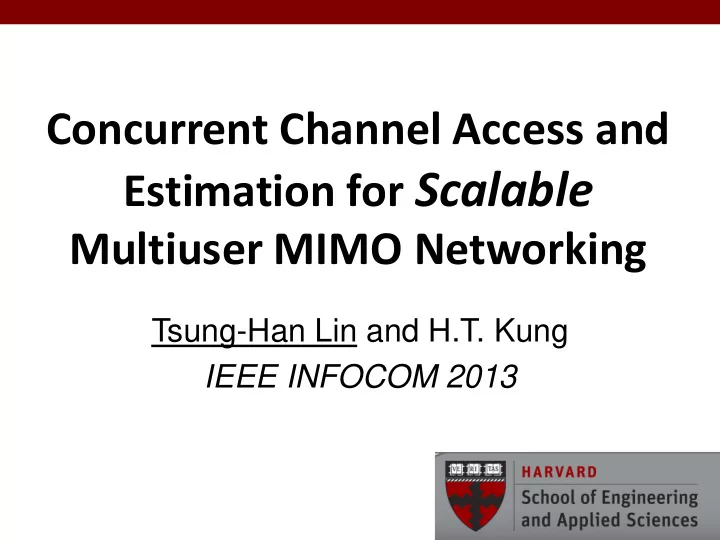

Concurrent Channel Access and Estimation for Scalable Multiuser MIMO Networking Tsung-Han Lin and H.T. Kung IEEE INFOCOM 2013
MIMO Communication • Multiple antennas create additional degree-of-freedom • Limited by scattering environments Rx Tx
Multiuser MIMO • Rich spatial diversity from geographically separated users • K antennas on the AP, expect K -times throughput improvement User AP User User
Proposed Concurrent Access to Mitigate MAC Scalability Issue for MU-MIMO Preamble Data frame Staggered Access Scheduled Access No coordination Full coordination Minimum Fully control parallelized overhead data frame Concurrent Access
Proposed MU-MIMO Concurrent Access in Support of Random Access • More aggressive senders, i.e., smaller backoff window size – Standard tricks applied (e.g., CSMA with exponential backoff) – Automatically adapt to additional degree-of- freedom • No coordination – Senders choose to join concurrent transmissions independently
Challenges of Concurrent Access and Proposed Solutions • Challenge: Precise synchronization is difficult – Proposed solution: Channel estimation from loosely synchronized preambles – Can be cast as a sparse recovery problem • Challenge: Collision is expensive under MIMO – Proposed solution: Use delay packet decoding to exploit retransmissions to decode previously collided packets
Rx Tx pkt Preamble Receive window d1 d2 d3 Channel estimation with packet preambles measures channel distortion on data symbols
Rx Tx pkt # unknowns (h1, h2, Receive window etc.) in channel estimation proportional d1 d2 d3 to delay spread d1 d2 d3 Delay spread Multiuser case is y 1 d 1 h 1 analogous to multipath, y 2 = d 2 d 1 h 2 but with much larger y 3 d 3 d 2 “delay spread”
Tx2 Rx Tx1 Receive window # unknowns is d22 d23 d21 d22 d23 proportional to sync offset, and d12 d13 d11 d12 d13 # senders Synchronization offset y 1 d 22 d 12 h 11 d 21 d 23 d 11 d 13 0 + y 2 = 0 d 22 d 21 d 23 0 d 12 d 11 d 13 y 3 0 d 23 d 22 d 21 d 13 d 12 d 11 h 21
Path delay (tap) t 1 t 2 t 3 t 4 Scheduled and Sender 1 Sender 4 fully synchronized Sender 7 # unknowns = (# senders) x (# path delays) t 1 t s Sender 1 Random access and Sender 4 loosely synchronized Sender 7 # unknowns = (# potential senders) x (# potential timing misalignments)
Potential Timing Misalignments t 1 t s Potential senders Sender 1 Map of Unknowns Sender n The dimensionality of unknowns is enlarged, but the amount of channel coefficients per transmitting sender is the same, i.e., sparse in the new space ... we just don’t know where they are
Compressive Sensing • A few random projections preserve all information of a sparse signal K -sparse Random linear Prophet target signal combinations K N O(Klog ) K N ~ 4K
Random Preamble Sequence • Assign senders random preamble sequences {1, -1} to create random measurements How long does the preamble need to be? Ex: 4x4 MIMO, delay spread 60 ns, time sync offset 2 μs , 100 potential senders Solve all vars Our strategy 100 x 2 = 200 μs 4 x (4 x 0.06) ~ 0.96 μs
Furthermore, Exploit Receiver Diversity for Decoding • N- antenna MIMO AP receives N copies of concurrent preambles – Channel coefficients to each antenna are different – Timing misalignment and senders are the same! • Leads to faster decoding and shorter preambles Tx2 Rx Tx1
Not there yet, random access based concurrent transmission also means collisions are likely Rx Full utilization Collision
“Delay Packet Decoding”: Exploit Successful Retransmissions Successful retransmission can be used to cancel out packets in previous collisions Rx h 1 P 1 h 1 P 1 h 3 ‘ P 3 h 2 P 2 h 2 P 2 h 3 P 3 Collision Retransmission Decode Need to learn h 1 , h 2 , h 3 from collided packets
Enable Concurrent Channel Estimation for Collided Packets • Most collisions are caused by only a few additional packets • Slightly longer preamble allows concurrent channel estimation of these collided packets Packet 1 Can perform Packet 2 Cannot decode concurrent channel MIMO data frames Packet 3 estimation Tolerate small fluctuation in channel booking
System Evaluation with a Software Defined Radio Testbed
10MHz clock to synchronize USRPs 4 USRPs as four distributed users USRP-N200 operates at 916MHz, 6.25MHz bandwidth MIMO-OFDM 4 synchronized USRPs as one AP
Concurrent Channel Estimation vs. Sequential Channel Estimation Clean, sequential preamble Concurrent preamble Sparsity constraint removes USRP-N200, 4x4 MIMO unwanted noise 6.25MHz Bandwidth 13 taps
4x4 MIMO Decoding Performance Low SNR, sparsity High SNR, assumption delivers decoding more accurate performance is channel estimation similar Concurrent Preambles Decoded SNR using Decoded SNR using Sequential Preambles
Number of Active Transmitters a Preamble Length Can Support Best one can do: If senders and timing misalignments are known FFT=128 FFT=256 4 antennas Successful recovery rate (%) 1 antenna
Aggregated Throughput Improvement Concurrent Access Concurrent Access w/o delay packet decoding Staggered Access (avoids preamble collision) Simulation: PHY 52Mbps 1500-byte packet
Aggregated Throughput Improvement Concurrent Access 210% Staggered Access (avoids preamble collision) Simulation: PHY 52Mbps 1500-byte packet
Throughput Scalability Concurrent Access Concurrent Access w/o delay packet decoding Staggered Access Simulation: PHY 13Mbps 1500-byte packet
Conclusion • Concurrent access allows efficient and scalable multiuser MIMO networking without strict synchronization and coordination • Key enabling techniques – Compressive sensing to relax synchronization and coordination – Delay packet decoding to tolerate demand fluctuation in random access
Recommend
More recommend